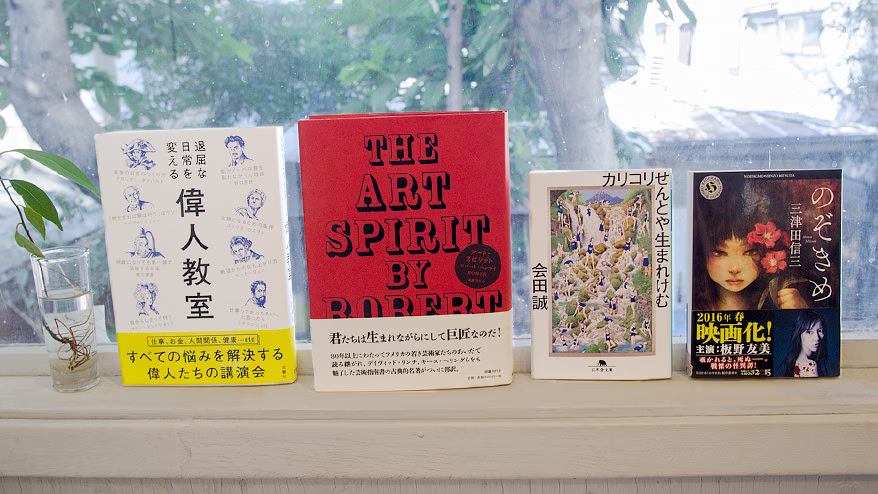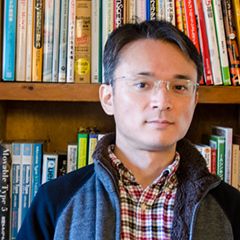Monosus' reading group meets once a month.
"Each person will bring a book and read it for the first 40 minutes (it's okay to read only part of the book)."
"Each person will give a 5-minute presentation on their impressions of what they read."
The meeting will proceed in this order. (Please see the first meeting for the purpose of the meeting.)
Up until now, we have mainly chosen more serious books such as self-help and business books, but this time we narrowed the categories down to novels and essays and asked the participants to choose books.
The participants were four people: Kikunaga, Matsubara, Nakaniwa, and Murakami.
Following on from last time's hot sandwiches, the reading group began with muffins and shrimp crackers selected from the courtyard.
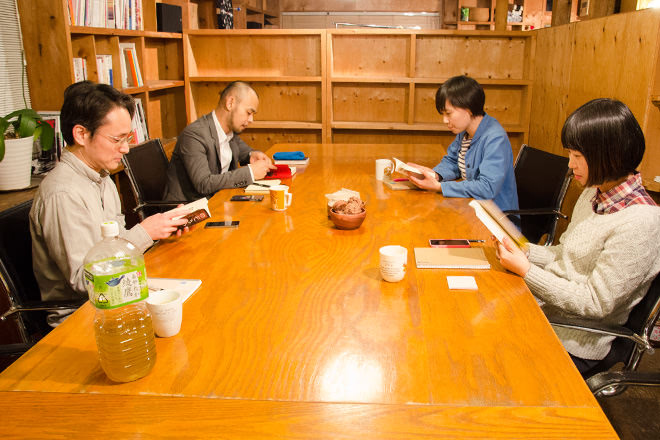
Presentation Time
After the 40 minutes of reading, each person will have 5 minutes to introduce their book.
- Hints on how to live from 26 great people by Iota Tatsunori, "Changing the boring everyday life: Great people class" (by Matsubara Megumi)
- If you are spied on, it's the end. Such is the fear. Shinzo Mitsuda's "Nozokime" (reviewed by Izao Murakami)
- When a contemporary artist takes up his brush, this is what happens: Aida Makoto's "Was I born to be a Kalikori Sento?" (by Nakaniwa Yoshiko)
- I'm trying my best to convey that message.
"The Spirit of Art" by Robert Henri (introduced by Shinsuke Kikunaga)
Tips on how to live from 26 great people
Iota Tatsunari "Great People Classroom: Changing Your Boring Everyday Life" (reviewer: Matsubara Megumi)

Iota Tatsunari (author) "Great Person Classroom: Changing Your Boring Everyday Life" Bunkyosha 2016 ( Amazon )
I picked up Matsubara at a bookstore. I was interested in him because he was the author of " Why Does Water Have No Color? ", which I had previously read at a book club.
"These are lectures in which famous historical figures, whose names are well known to everyone, look back on their lives and offer hints on how to live in their own words. It's like a live talk by these great people."
As explained at the beginning, 26 great people appear in this book. For example, Ryoma Sakamoto appears and says, "Hello, I'm Ryoma Sakamoto," and talks about his life. His success stories and failures are interesting and give you hints on how to live your life. It kills two birds with one stone by giving you an understanding of the lives of great people whose names you only knew.
The most interesting of all was a lecture by Chikamatsu Monzaemon on the theme, "It's good to just go with the flow in life."
He was a scriptwriter for Bunraku puppet theater in the Edo period. He became a scriptwriter due to the influence of those around him, and after writing works that people said they wanted to read, they became quite popular.
He was sometimes envied by those around him, but he simply did his best to meet the demands of those times. He also lived with pride in being a samurai, rather than simply following orders.
The message was that life is just right, to have those things that you can't compromise on, but also to just go with the flow with those around you.
I don't really have anything in particular that I'm "there," so I thought it might be nice to just go with the flow and live life (laughs).
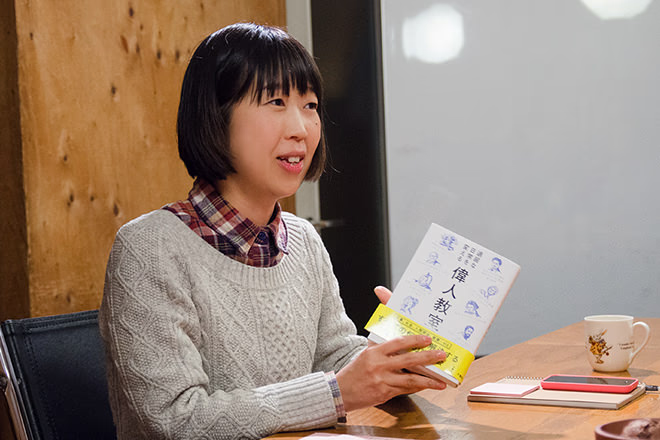
Murakami: Who else are there great people?
Napoleon Matsubara, Hideo Noguchi, Ieyasu Tokugawa, Captain Cook, Florence Nightingale, Marie Antoinette, Van Gogh, etc. There is a great variety of eras and countries.
I'm interested in this because I like Murakami and Tokugawa Ieyasu.
It was written that Matsubara Ieyasu was "in good health." It seems he was very conscious of his health.
If you are spied on, it's all over. Such a fear.
Shinzo Mitsuda's "Nozokime" (reviewed by Izao Murakami)

Shinzo Mitsuda (author) "Nozokime" Kadokawa Shoten 2012 ( Amazon )
Murakami: This book is a novel that combines mystery and horror, and the narrator is in the first person, "I," but is probably the author himself.
The story begins when the narrator obtains a notebook written by a folklorist about the strange phenomena he has encountered, and I thought it was interesting that the distinction between reality and fiction is not clearly defined.
This novel is in two parts; the first is set in the present day and tells the story of a teacher the narrator knows.
When the teacher was a university student, he went to a resort deep in the mountains for a summer part-time job and was told by the caretaker of the villa that it was a place he shouldn't go to, but as is often the case in these stories, he ended up going there anyway. He ended up getting lost in an abandoned village and having a frightening experience, and although he somehow managed to return home, strange things continued to happen after that... That's the story.
The second part is set in the 1930s, and based on notes left behind by a folklorist, we will solve the mystery of what once happened in the abandoned village that appeared in the first part.
I like folklore stories, so I find it interesting when the setting of a story is a village where old customs and traditions still remain. Of course, I don't want to live in a place like that, and just hearing the stories is satisfying, just like ghost stories.
I'm currently reading the second part, in which the protagonist, a folklorist as a young man, visits the village, and I'm looking forward to seeing how the story unfolds.
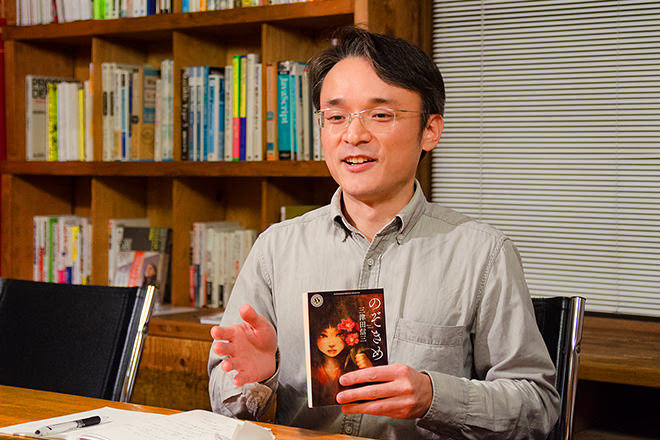
Will there be someone like Kikunaga Jason?
There are no splatter -like depictions. In the first part, no one is directly harmed, but rather, as the title suggests, they are "peeked at." The person who is peeked at dies mysteriously. It's pretty terrifying to imagine a situation where you feel the gaze of something you don't know all the time.
In the end, is it possible that a human is the culprit in the courtyard ?
I've only read part of it so I don't know what's going to happen, but that's the case in other works by Murakami . It's a horror story, but one of its features is that it logically interprets the strange happenings and solves the mystery, but there are still things that remain unexplained until the very end.
There were also other interesting works whose endings took advantage of the "book" framework.
This is what happens when a contemporary artist picks up his brush
Makoto Aida "Was I born to be a Kalikori Sen?" (reviewed by Yoshiko Nakaniwa)
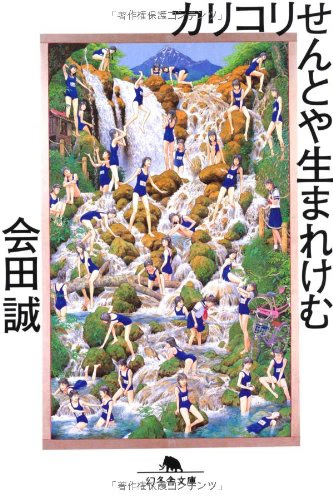
Makoto Aida (author) "Was I born to be a scientist?" Gentosha 2012 ( Amazon )
Do you know Nakaniwa Aida Makoto?
He is a contemporary artist of the same generation as Takashi Murakami and Yoshitomo Nara, and is said to be a representative artist of "New Japonism."
For example, the cover art shows a waterfall landscape reminiscent of a Japanese painting, with junior high school girls in school swimsuits scattered throughout (laughs).
His works are often eccentric, featuring beautiful girls and lolicons in a style that combines Japanese painting and illustration, as well as ironic portrayals of war and political themes, but this collection of essays is also quite interesting.
The topics he talks about include his family home, his wife and children, Togane where he lives, young artists and contemporary art, his favorite beautiful girls, and his hobbies and interests.
First of all, what does the title mean? Can you imagine what "Kalikori" is? You might think it's some kind of onomatopoeia, but it's a word unique to the Aida family that refers to the act of having someone scratch your head. According to Aida, a self-proclaimed Karikori addict, Karikori has "an ecstatic feeling," "magic," and "an act of communication," and its powers can "deter war," "achieve lasting peace," and "fundamentally save humanity."
In other words, this is a caricature of the "concept" itself, explains Saito Tamaki at the end of the book.
"War" and "peace" are important themes in the concept of contemporary art, but I thought it was quite impressive that he said, "Kalikori is something that will deter war and bring about lasting peace," making the concept of contemporary art itself nonsense.
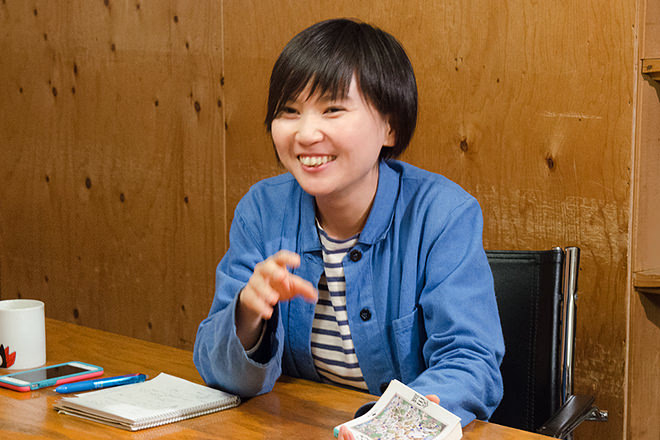
Murakami: What story was particularly interesting?
At the beginning of the first courtyard is an episode called "The Curry Incident." It's a story about Aida's family home, which he describes as "a slightly terrible family," and he calls himself a "failure" for having grown up there. I thought to myself, "I'm using that as material to make a living through art now."
The second story is about his wife (Okada Yuko) who is worried about her son (Tora-san), who has ADHD and is having trouble fitting in at school. Perhaps because Aida himself had ADHD as a child, he calls his son "the star child" and sees him in a fairly positive light. Meanwhile, his wife is very worried and complains to her husband, but Aida tells her, "If you're even a creative person, why don't you write and express yourself to the world instead of complaining to me?" and has her write a column for him (which he was too busy preparing for an exhibition to write). The wife's writing is also very interesting...
Is Mrs. Matsubara a writer?
Courtyard : Yes, his wife is also a contemporary artist. He and his wife and son formed a unit called "Aida Family" and exhibited at the Museum of Contemporary Art Tokyo last year, and their manifesto "Speaking out to the Ministry of Education, Culture, Sports, Science and Technology" became a hot topic.
Matsubara : I didn't think of Aida Makoto as that kind of person because he's famous for his drawings of cute girls. By expressing himself as an artist, rather than as a politician or critic, he's able to express things that normally can't be said to the fullest extent possible.
Although he says things like "I'm an idiot," he still manages to incorporate criticism into his work. And he's very good at writing (laughs). For him, writing is also a form of expression.
I'm trying my best to convey that message.
"The Spirit of Art" by Robert Henri (introduced by Shinsuke Kikunaga)
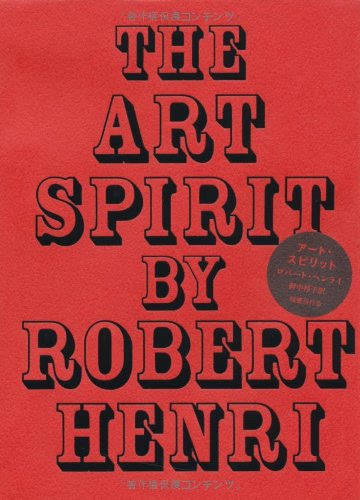
"Art Spirit" by Robert Henri (author), Makoto Takimoto (commentary), Kuniko Nonaka (translator), Kokusho Kankokai 2011 ( Amazon )
Kikunaga Robert Henri (1865-1929) was an American painter, and this book mainly consists of the notes of his art lectures, but also includes some letters and notes.
At the beginning it says, "Art is life."
Even in the midst of an ordinary day, there are happy moments and once-in-a-lifetime moments. Art and life are about not missing out on those moments and how to express them in a work of art, and I thought this book was trying to capture the "essence of the world."
For example, the fact that beauty is only beautiful when various things are related to each other can be applied to the relationship between people. Reading this book can be a study of art, and you can pursue the essence of the world through beauty. It can be applied to work, and since I play music, I thought it would be applicable to that as well.
And the essence of that is passion.
The reason I was drawn to this book is because I felt a great deal of passion in it. Even just from the bright red cover (lol)
Right now, I have the desire to try my best at many things, but sometimes I lose confidence in whether I have the passion within me. That's why these words by Robert Henri really resonated with me.
If you don't care, you can just go about your life aimlessly. But that's not the case. I want to have passion. I'm inspired by this book and want to express myself in many different ways.
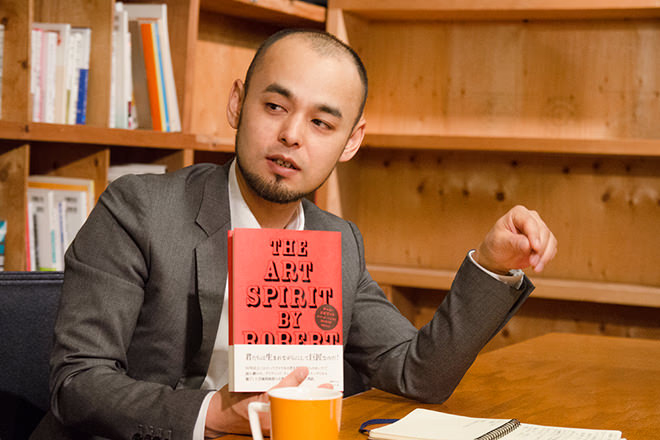
Murakami: The subject is about art.
Kikunae : Yes. I want designers to read it too. It's about beauty, and the words are very passionate. He chooses a theme and does his best to convey it to his students.
His students included Edward Hopper and Man Ray.
Do you keep this book in mind when you write songs, Kikunae Nakaniwa?
Kikunaga : There are some parts where I am trying to connect them. I think that the poems and songs I write are pictorial, and the moment they become logical, I get sick of them and want to destroy them. That's why I think I have to learn from this person all the more. It's not enough for a painter to have excellent sensibility, and the paintings of a painter without intelligence are superficial. Intelligence and knowledge are very important.
After the reading group
This was the first attempt to set a theme in advance. Essays and novels were a way to refresh the minds of those tired from work, and it also gave a glimpse into each person's hobbies and preferences, making it a reading group with a unique flavor.
We also came up with various ideas for the theme of the next reading group. We could try a theme based on the genre or the feeling after reading. We could each bring a recommended book and exchange it with the other person's book.
For our next reading group, we would like to have a theme of "books you want to read while staying indoors."
